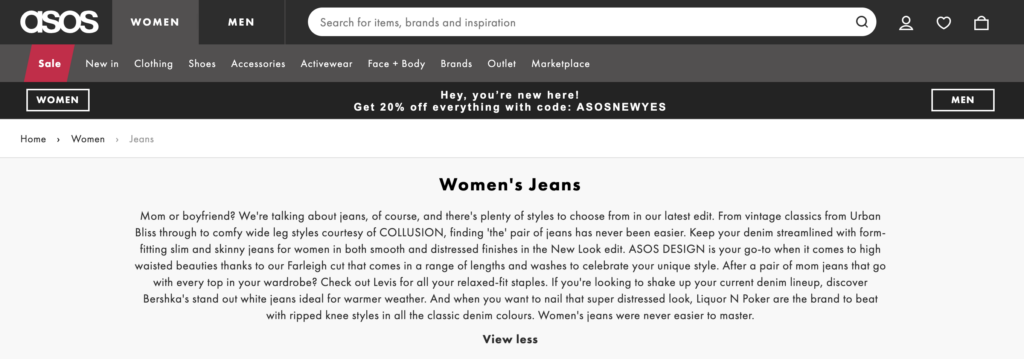SEO is about optimising your website and improving its organic rankings, done by the programs and bots that crawl your website and analyse its individual pages.
The most effective and strategic way to do this over the long term is with supportive, substantial content and copy.
The core goal of your content is to have more visitors engaged on your website pages for longer. When you create consistent, original, useful content you are investing in better SEO results.
It’s not just that Google counts the words and ranks you on that word count – it’s because good quality longer form content keeps people on that page longer – which boosts your ranking.
What is supportive content?
We talk about the need for supportive content with clients all the time. It’s fundamental to SEO because once we have identified the keywords that you want to rank for – the questions and queries that your ideal clients would type into a search engine – then we need content about them to optimise.
So the more content you put on your website about the things your customers will be searching for and the problems they are trying to solve, the better.
When we start working with a new client and research their keywords, we have a good look at what’s on page 1 for those keywords – and what we find consistently is that the pages that rank best are the ones with lots of copy about their customers’ problems and their solutions.
And when our clients create that supportive content and we optimise it, we see immense improvements in their keyword rankings.
It makes them much more competitive online – because their competitors are often doing it. Better yet, if they’re not doing it then you’re already one step ahead.
Where do you put supportive content?
(Everywhere you can 🙂 )
Supportive content can be anything, really – it includes blog posts, services pages, landing pages. The key is to have good quality, helpful, readable content and copy that uses your keywords naturally and appropriately. The major search engines are way too smart today – you can’t just repeat the same words and phrases over and over. (That will get you a “Google slap” pretty quickly.)
For example, one of our clients Outcome.Life is an internship provider, helping international students into internship placements for work experience. They wrote a blog post that is a really informative, step-by-step guide on how to fill out your internship logbook – including examples of bad entries and how to improve them.
That one post was so good that it won them a Featured Snippet with Google – which is even better than a #1 ranking because it gets displayed right at the top of Google’s search results.
There are some pages that we regularly find that people have overlooked.
Category and product pages on eCommerce websites are a good example – it’s quite common for us to find that a new client has an awesome product range – but the category page is virtually a copy-free zone. Make your category and collection pages helpful, information-rich explanations of your products and the problems that they solve for the people who buy them.
Make sure that any product pages have lots of supportive copy in their “description” and “additional information” tabs. Too often, we see product pages with just one sentence in the description – and that’s a waste of valuable online real estate.
A helpful, well-written category or product page with relevant, optimised meta tags means that when Google crawls the page it’s clear what it’s about and it can see that the content is consistent with the headings and the meta tags. This is how to get Google to reward you with higher organic visibility.
Supportive content is helpful to your visitors
Write with your end users in mind – think about who they are, their demographic, their needs and what they are wanting to achieve, such as international interns who want to get work in Australia.
Supportive copy helps you build influence and trust, which is fundamental to increasing your online success. It helps you to demonstrate your authority and lets visitors get to know you, like you and understand the benefits of what you offer.
Supportive copy isn’t all about what you do or the features of your products. Supportive copy is about the results that your customers are seeking and how you help them achieve those results.
Be substantial as well as supportive
Make your content long enough to be really useful to your website visitors for best results. This can feel challenging, but it’s worth the time investment. Both Google and your visitors will reward you for it.
Some people will tell you “don’t write too much” – but that advice is well out of date.
Information-rich copy doesn’t have to be overpowering – as long as it’s written to be easy to read. There are a range of readability tools available to help you check your content.
But how do you create it in the first place?
Tips for writing substantial, supportive content and copy
The idea of writing a long article can seem a bit confronting when you’re staring at a blank computer screen. So here are some suggestions to help you develop good long-form content:
- Write with your end user in mind.
Think about your customers – their age, their gender, their work, their values, their goals, the language they use.
- Write helpful content.
Think about a challenge that your end users are dealing with – and write content that can help them with that challenge. (HINT: read through your customer testimonials for what they value)
- Once you’ve picked a topic, get specific.
A useful tool we’ve written about before is 4MAT learning – where you answer these four questions in this order – Why? What? How? What Else? (HINT: open a doc and put in those headings about your topic)
- Talk your content out first.
Separate out your thinking from the mechanics of writing and talk your content first. Find a listener and talk to them about the topic, recording what you say. It’s easier than ever before with conferencing tools like Zoom, PLUS low-cost transcription tools such as Otter.ai that can turn the audio into text quickly and easily. - Use quotes and excerpts (with attribution)
If someone else has a good idea, share it. Quote them and then explain why it’s a good idea for your end users to consider based on your experience or expertise. Make sure you attribute the idea, of course! - Include case studies and examples
Telling a story is engaging and entertaining, as well as explaining your idea and creating extra content. When you’re giving examples, it can be useful to create a contrast between “what to do” and “what NOT to do”.
SEO is extra powerful when you have substantial supportive content
Well-written, substantial supportive content – especially when it’s well-optimised – is the ultimate way to really rank for the keywords you are targeting. It’s a win/win – because Google likes it AND because it’s an excellent way to make a good impression with your website visitors.
So make it something you invest in regularly – whether you write it yourself or engage a professional to do it for you.




